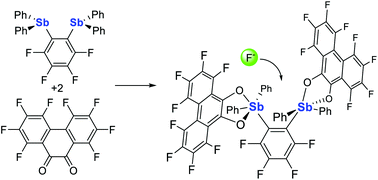Distiboranes based on ortho-phenylene backbones as bidentate Lewis acids for fluoride anion chelation†
Abstract
As part of our efforts in the chemistry of main group platforms that support anion sensing and transport, we are now reporting the synthesis of anitmony-based bidentate Lewis acids featuring the o-C6F4 backbone. These compounds can be easily accessed by reaction of the newly synthesized o-C6F4(SbPh2)2 (5) with o-chloranil or octafluorophenanthra-9,10-quinone, affording the corresponding distiboranes 6 and 7 of general formula o-C6F4(SbPh2(diolate))2 with diolate = tetrachlorocatecholate for 6 and octafluorophenanthrene-9,10-diolate for 7, respectively. While 6 is very poorly soluble, its octafluorophenanthrene-9,10-diolate analog 7 readily dissolves in CH2Cl2 and undergoes swift conversion into the corresponding fluoride chelate complex [7-μ2-F]− which has been isolated as a [nBu4N]+ salt. The o-C6H4 analog of 7, referred to as 8, has also been prepared. Although less Lewis acidic than 7, 8 also forms a very stable fluoride chelate complex ([8-μ2-F]−). Altogether, our experiental results, coupled with computational analyses and fluoride anion affinity calculations, show that 7 and 8 are some of the strongest antimony-based fluoride anion chelators prepared to date. Another notable aspect of this work concerns the use of the octafluorophenanthrene-9,10-diolate ligand and its ablity to impart advantageous solubility and Lewis acidity properties.

- This article is part of the themed collection: p-Block Lewis Acids in Organic Synthesis


 Please wait while we load your content...
Please wait while we load your content...